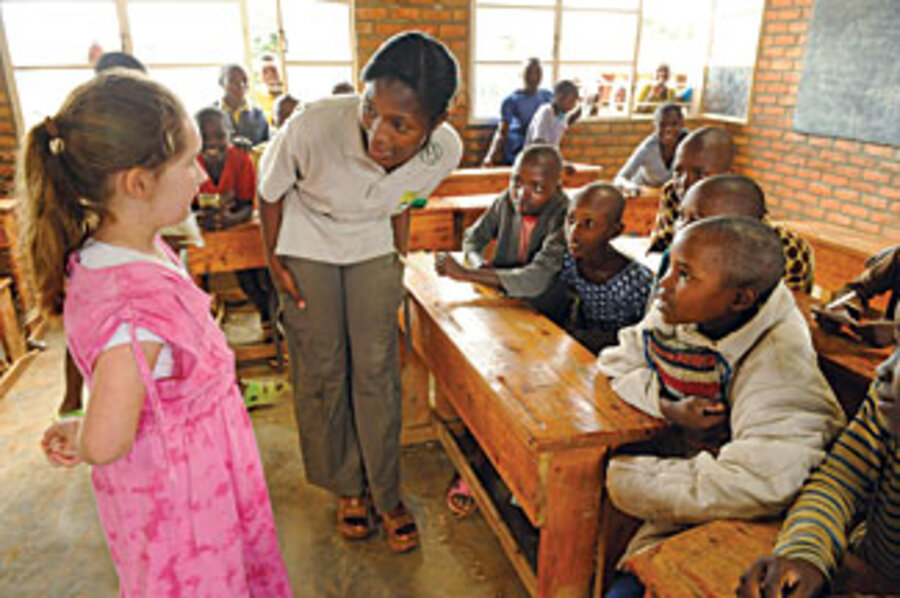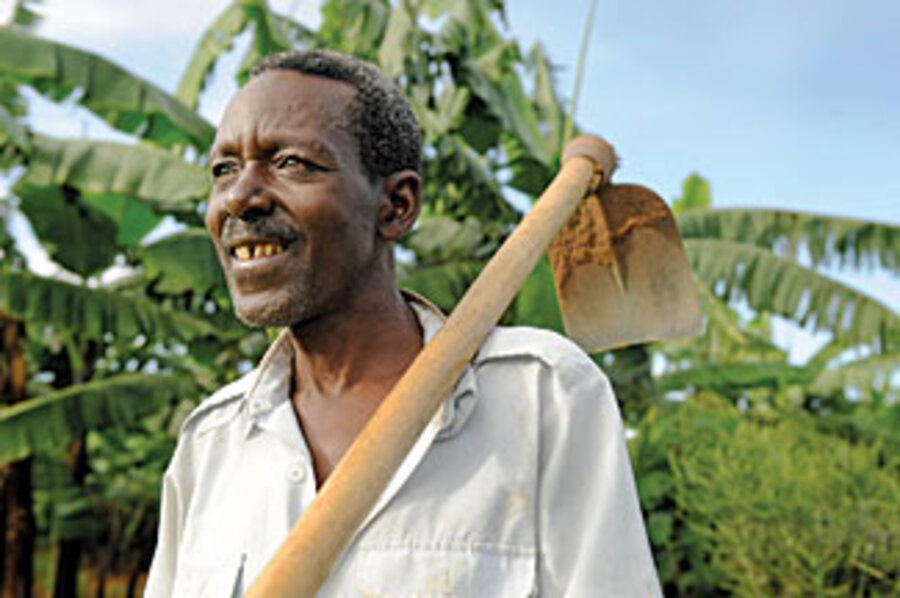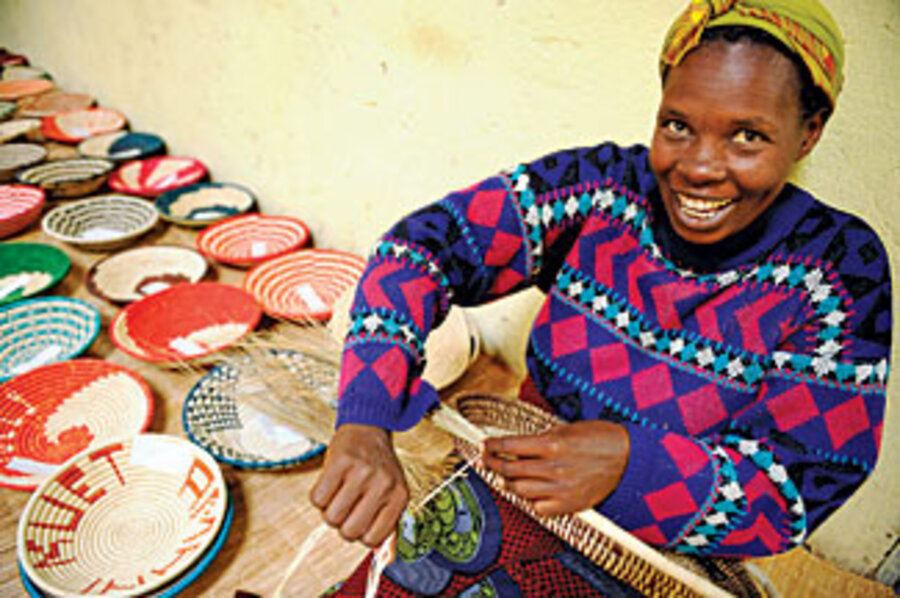Poverty tours travel a fine line
Loading...
| Mayange, Rwanda
Jeanne d'Arc Mukamurigo and her daughter sit on a bench in the shade of a tree, twisting stiff, skinny threads of red bamboo into place mats. Weaving isn't something she grew up doing, and place mats aren't particularly Rwandan, but she spends a few days a week turning finicky threads into things white people will buy when they visit this village, about an hour's drive south of Rwanda's capital, Kigali.
Ms. Mukamurigo is a member of Imirasire, a collective of women taught to weave baskets, place mats, and coasters and sell them to tourists. Tourists are new to Mayange, where 25,000 people live in an arid part of Rwanda.
As Mukamurigo and her daughter finish off their latest creation, an SUV pulls up near their bench. Four mzungu, the local term for white people, shuffle out and watch silently as she curls the bamboo into a cable.
One mzungu lingers, while the others peruse wares on sale, to ask Mukamurigo about her work. She answers questions politely, and then says in a playful near-whisper, her low voice a sign of respect, "Stop talking to me and go buy something."
Tour operators raised their eyebrows at the story later, wondering haltingly if the gentle nudge was offensive. At the same time, they say they hope contact with tourists inspires further entrepreneurial thinking among the residents of Mayange, a village that has, until recently, been consigned by its geography and history to destitution. In 2005, the United Nations effectively adopted Mayange, selecting it as one of 80 model villages across Africa, where strategies intended to cut poverty in half by 2015 are being tested.
It's Mayange's status as a "Millennium Village" that draws crowds down from Kigali. But the full-day tour of a local farm, school, and health clinic, among other sites, exemplifies a fast-growing trend in global travel.
From the favelas of Rio de Janeiro to the townships of Cape Town, well-to-do Western tourists are plunking down serious dollars to see how the other five-sixths live. Like all tourism, this experiential off-roading can be a mixed bag for the local people, damaging the environment and threatening the authenticity of culture.
The bad kind has earned a seedy-sounding nickname – "poorism" – that means to suggest what experts say can be little more than a voyeuristic excursion to see just how poor the poor really are.
But there's a more compassionate kind of poverty tourism, known by a spectrum of labels, that delivers more money to the countries tourists visit and puts more of their cash in impoverished locals' pockets. The best of these programs take foreigners into local communities and expose them to authentic, indigenous ways of life, while taking heed of the cultural and environmental costs of tourism.
"Whether it's ecotourism, green tourism, responsible tourism, sustainable travel, geotourism, community-based tourism – these are labels for the same thing, the responsible spending of money," says Ethan Gelber, who works with WHL.com, which connects tour operators in places off the electronic grid to mostly Western, online customers.
It's a movement fueled as much by curiosity as by conscience. Harold Goodwin, a professor at Leeds Metropolitan University in England and a leader in the responsible-tourism world, says Westerners are growing more curious about places that seem wealthy in ways their own homes may not.
"Often, rich Western tourists are interested to see people who have a strong cultural and social ethic – which they often don't have themselves," he says. "One thing that's clear is … that the economic poor are often culturally rich."
South Africa's townships have become some of the most popular destinations of this kind. Michael Huber, an Austrian who visited Cape Town last summer, says he wanted to understand the legacy of apartheid in the townships, but the idea of visiting other people's poverty made him uncomfortable.
"I think I always had the fear of … looking at other people in a way that basically makes them a spectacle," says Mr. Huber, a newspaperman who took a tour of Langa Township, one of several areas where blacks were relocated under apartheid. "But I was able to talk to people and get their perspective, have them reassure me that it's an OK thing to do, that it actually means something to them. And I learned a lot about life in a South African township that I only could have learned by actually going there."
In Rwanda, a few small-scale companies try to capitalize on gorilla trekking by offering side trips to communities in the country's northwest. The Millennium Village tour, run by New Dawn Associates, a tourism agency based in Kigali, is a departure from most add-on tourism in Rwanda, where day-trips tend to focus on genocide memorials.
"We work with people who would like to have … a holistic experience – see the culture, the authentic local life," says Michael Grosspietsch, one of the company's founders. "It's a combination of real tourism and education."
Nearly 500 tourists, paying about $90 each, have visited Mayange since tours began in mid-2007. Seventy percent of New Dawn's profits, roughly $35 per person per tour, goes back into the village. Most of it is donated to the local tourism cooperative, which has sprung up independent of both New Dawn and the UN, to make decisions about how to invest the tourism windfall and to generate ideas to attract even more visitors.
A token sum also goes directly to the people whom tourists visit. One of those is Apollonaire Rwabuzisoni, who farms cassava, bananas, and sorghum on his small plot. On a woven mat in front of his home, his wife dries sorghum seeds she'll use to brew a local indulgence. His cow chomps grass in a small thatch-roofed hut.
Mr. Rwabuzisoni leads visitors down a skinny dirt path to his cassava patch. He hacks with a hoe at the roots of what looks like a sickly weed with tall, crooked branches and thin green leaves. After about a minute, he uncovers a long, plump cassava root. He peels it with a sharp knife, then offers visitors slices; it has the texture of coconut, meaty and milky, and the bitter taste of potato peels.
Rwabuzisoni's farm is on the tour to show visitors how the UN's intervention helps local farmers. Planting in rows increases output, and the cassava Rwabuzisoni grows is genetically modified to give a beefier root than most. He'll make about $2 for his time with the tourists, and a dollar more for the root he's dug and diced up to serve them. (Ninety percent of Rwandans live on less than $2 a day.) For no extra charge, he sends each visitor off with a few bananas from his trees.
"It's part of Rwandan culture" he explains. "If someone visits you, it's not right that they leave without eating something."
So Ms. Murungi takes tourists to a tailor and a hairdresser, where visiting women like to get a small piece of their hair braided. They wander through the market, where guides point out food: the sweet-and-sour ibinyomoro, diamond-shaped red fruits called "tree tomatoes," or small, green Rwandan eggplants that end up tough and bitter in the hands of inexperienced cooks. These are all things Rwandans would gladly show any ordinary visitor, sans SUV and prepaid tour package; the country has largely cultivated a tradition of hospitality, and locals are usually welcoming without the promise of a few dollars.
But Josh Ruxin, who founded the Millennium Village at Mayange in 2005, says the conceit of a tour alters the relationship between foreigners and locals in a beneficial way. After generations of well-intentioned handouts from tourists, who bring everything from candy to soccer balls, "the perspective in kids is, 'Outsiders come to give us stuff,' " Mr. Ruxin says. "We need to turn that on its head. Tourism shows, 'This community has value, for which we will be paid.' It's a totally different way of thinking about mzungus."
It's also a totally different way of thinking for the mzungus. Grosspietsch's clients say they see Rwanda as an optimistic country making admirable, if incremental, steps toward economic prosperity.
"We have been on every continent except Antarctica," Donna McNeese-Smith, an American, says of her and her husband, "and I can't think of any trip we've enjoyed as much. The places we went were all places that were contributing to progress in Rwanda."
They say the tour also showed them the human side of the country's immense everyday challenges. Over a lunch of rice, beans, and goat meat at an orphanage for young adults who survived the genocide, "I asked … if this was what they ate all the time," Ms. Mc-Neese Smith says. "They said, 'Pretty much, except they only have meat and Coca-Cola when you come, because you pay for the meat."
McNeese-Smith and her husband took their two-week immersion so seriously that they joined in umuganda, a community cleanup that happens nationwide on the last Saturday of every month. Together with locals, they picked up trash along the road in front of their hotel, Kigali's only five-star. "They enjoyed seeing us doing manual labor," Bill McNeese-Smith says. "They thought we were maybe beyond that somehow."
Other tourists have been inspired to help out when they get home. Helen Kweskin, an English teacher at a private school in Stamford, Conn., went to Rwanda on a professional exchange, managed locally by New Dawn.
Inspired by the hard work of her colleagues in Rwanda, Ms. Kweskin started a nonprofit organization to raise funds to buy books, school uniforms, and other educational supplies. "If they need books, it seems the least one can do here is bloody well find them books, or school uniforms, or sports uniforms," she says. "It's not so hard."
But this spring, Mayange farmers will harvest their first crop of pomegranates, introduced after a suggestion by a visitor from the US. And if you visit Rwabuzisoni, he'll invite you inside and show you a picture of him and his family with an Australian couple who came here last year. It hangs in his home's place of honor, between a drawing of Jesus and a drawing of Mary.
"I'm black, and they're white, and they come from so far. To travel so far and be friends, for them to send me something – it amuses me very much," he says with a wide smile. "I only wish the visitors could spend a long time, maybe drink some fruit juice, maybe eat some eggs – you all like eggs so much. I wish we could talk for hours. I hate when you run away."
[Editor's note: The original version spelled "Mayange" incorrectly throughout the text.]








